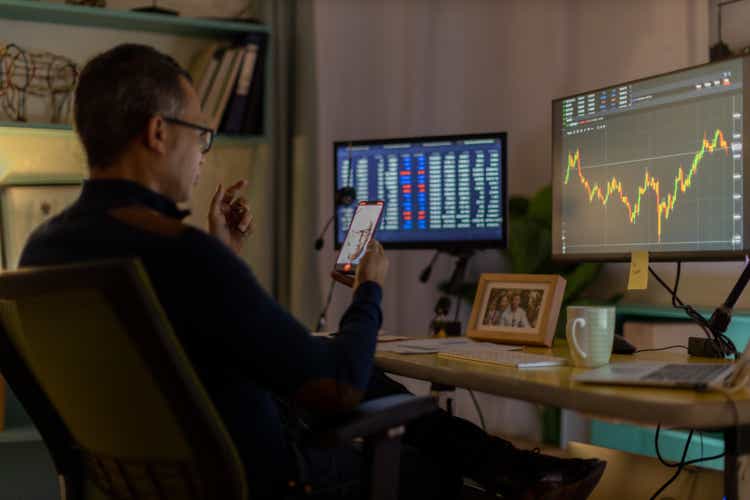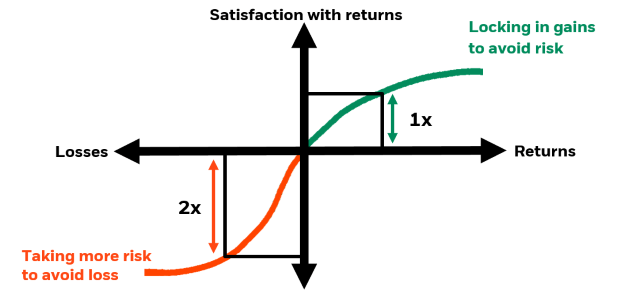Alistair Berg
Transcript
Last week’s rate hike by the Fed is another sign that we have entered a new regime and more market volatility may lay ahead.
Avoiding investor bias in an era of volatility
We think that warrants careful thought about behavioral biases, as these subconscious influences on investment decisions are exacerbated by volatility. We look at three biases and what to do to avoid them:
1) Inertia bias
First, inertia, an aversion to change, or only making small, insignificant ones – can be costly now if your portfolio is still positioned for the previous regime.
2) Disposition bias and the endowment effect
A reluctance to rotate out of losing positions or mechanically adding to them, taking more risks to avoid the pain of a loss, is the disposition bias. Another bias to be aware of is the endowment effect. It’s when investors keep assets they wouldn’t buy today.
3) Three methods to mitigate bias
So, how would we avoid bias?
First, imagine you have realized all your gains and losses. Then construct the ideal portfolio. Don’t abandon your investment process, but move away from small changes anchored on status quo holdings.
Second, think of future market events that signal when to take profit or cut losses. That’s why our mid-year outlook shares the signposts we look at.
And lastly, openly discuss bias, acknowledging emotions regarding performance and risk-taking.
We are following our own advice, overhauling portfolios to prevent biases, and we stand ready to shift our market views.
__________________
Investors are strapped in for a market roller coaster in a new regime of increased volatility. Views on central bank rates are shuffling fast, as last week’s market reaction to the Fed’s rate hike showed. We think this warrants careful thought about portfolio changes. But change is hard. Behavioral biases subconsciously influence investment decisions. We look at three biases likely to trouble investors, especially in this volatile market – and share tips on how to overcome these pitfalls.
Pain vs. gain
Satisfaction With Gains And Losses In Behavioral Finance Prospect Theory (BlackRock Investment Institute, adapted from Daniel Kahneman and Amos Tversky, Econometrica 12, 1980)
Notes: The chart shows satisfaction levels from gains and losses relative to a neutral reference point. Black boxes show satisfaction magnitude along the S curve of risk tolerance – from risk-seeking (red line) to risk-averse (green line).
The first bias is the disposition effect, or the tendency to hold losing positions too long and sell winning ones too soon. We expect the disposition bias to be most prevalent when investors are feeling stinging losses – like so far this year. Both stocks and bonds have racked up declines not seen since the 1970s this year. Behavioral finance finds that people feel the pain of loss twice as strongly as they experience an equivalent gain as pleasurable (the red versus green arrow in the chart). As a result, people may hold on to losing positions to avoid the pain of a loss (bottom left in chart). Meanwhile, it’s tempting to lock in gains too soon on winning positions because of a reluctance to take more risk for only marginal benefits (top right).
There’s a second bias that should really be public enemy No. 1 today for professional investors: inertia. This is a reluctance to make changes or making ones too small to affect performance. Why is this especially a problem now? The era of steady growth and inflation known as the Great Moderation is over, we believe. A new regime of increased macro volatility is in its place. Yet, central banks appear to believe they can magically curb inflation and cause only a mild economic slowdown, as we wrote last week. We see more volatility ahead, as markets have rallied on hopes the Fed is about to change course and relax policy. That optimism is misplaced, in our view. All of this calls for professional investors to change their portfolios more quickly. It will be costly, in our view, to just follow playbooks such as “buying the dip” or make slow and minimal changes.
Endowment is the third kind of bias to guard against in the current market backdrop. Think of it as excessively deliberating over whether you may one day need something that sat collecting dust for years – whereas you clearly should be decluttering. People with this bias overvalue their assets. The longer they own them, the higher the price they demand to give them up. The endowment effect can lead investors to hold on to positions even after an investment strategy has played out. This can hurt performance. Positions often produce more returns earlier in their life spans, we find.
Tips to mitigate these biases
First, do a blank-slate exercise – imagine you have realized all your gains and losses. Then construct the ideal portfolio for the most likely market and macro environment over your time horizon. That doesn’t mean abandoning long-standing investment processes. Instead, consider portfolio changes without basing it on your historical portfolio holdings and performance. Second, think of future market events or performance thresholds that would signal when to take profit or cut losses. Making a plan can help determine how to react amid volatile markets and high emotions. This is the reason we give signposts for changing our views in our 2022 mid-year outlook. Third, encourage open conversations about biases and the changes required to overcome them. Discuss your emotions after losses, examine mistakes even when performance is good, and weigh input from colleagues with an alternative point of view.
Our bottom line
Beware of behavioral biases in investing. We are guarding against their pitfalls because we believe the new regime requires an overhaul of portfolios. We’ve reduced portfolio risk throughout this year. Our latest tactical move: an up-in-quality portfolio shift by downgrading developed market stocks and upgrading investment grade credit. We underweight U.S. Treasuries and overweight inflation-linked bonds, believing markets underestimate the new regime’s inflationary nature.
Market backdrop
The Federal Reserve increased the Fed funds rate by another 0.75% last week. U.S. stocks rallied as markets concluded the Fed’s pace of rate hikes will slow, while yields fell on news of stalling growth. The Fed still thinks hiking rates will only cause a mild slowdown. It has yet to acknowledge the stark growth-inflation trade-off: crush growth or live with some inflation. We don’t see a policy pivot until 2023, as data show persistent inflation. Expect more volatility until the Fed changes course.
This week’s U.S. jobs report is front and center. The report will be key as the Fed looks to the labor market for further signs of healing in production capacity. The Bank of England (BoE) is set to increase interest rates again. But we think it is nearing the point where it changes course. To us, the growth cost of further rises will lead the BoE to live with inflation above target.


Be the first to comment